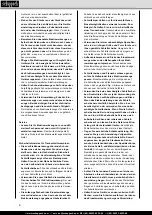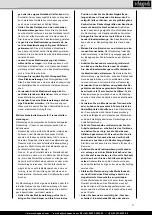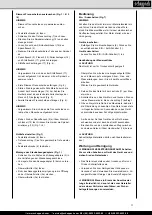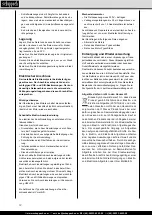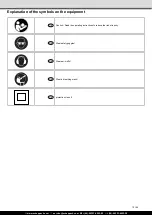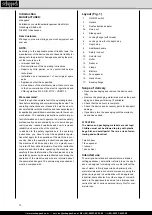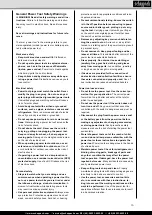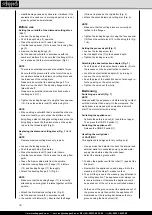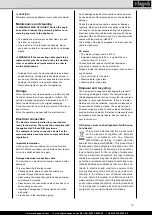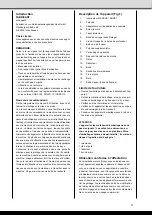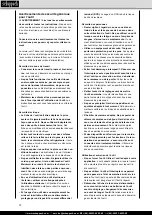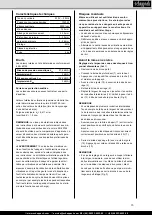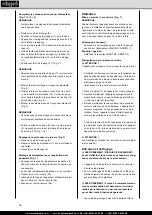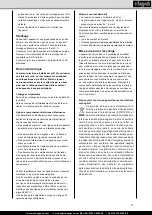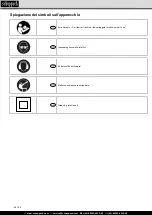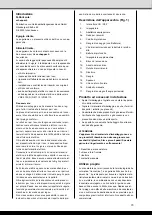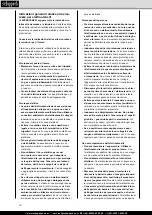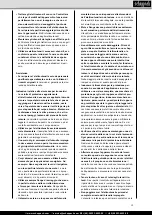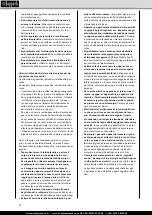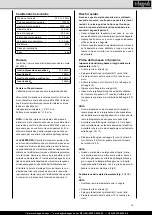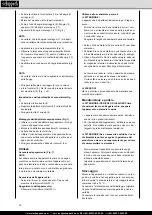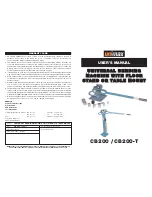
19
www.scheppach.com
+(49)-08223-4002-99
+(49)-08223-4002-58
www.scheppach.com
+(49)-08223-4002-99
+(49)-08223-4002-58
m
CAUTION!
Materials containing asbestos must not be machined!
Maintenance and cleaning
m
WARNING! RISK OF INJURY! Switch the appli
-
ance off and remove the power plug before com-
mencing any work to the appliance.
•
The appliance must always be kept clean, dry and
free from oil or grease.
•
Use a soft, dry cloth to clean the housing. Never
use petrol, solvents or cleansers which can damage
plastic.
m
WARNING! If the connecting cable needs to be
replaced, this must be carried out by the manufac-
turer or an authorised representative in order to
avoid safety hazards.
•
Grinding tools are to be treated with care and trans
-
ported carefully. Grinding tools should be stored in
such a way that they are not exposed to mechanical
damage or harmful environmental influences.
•
Never allow liquids to get into the appliance.
Storage
Store the device and its accessories in a dark, dry and
frost-proof place that is inaccessible to children. The
optimum storage temperature is between 5 and 30˚C.
Store the electrical tool in its original packaging.
Cover the electrical tool in order to protect it from dust
and moisture.
Store the operating manual with the electrical tool.
Electrical connection
The electrical motor installed is connected and
ready for operation. The connection complies with
the applicable VDE and DIN provisions.
The customer‘s mains connection as well as the
extension cable used must also comply with these
regulations.
Important information
In the event of an overloading the motor will switch
itself off. After a cool-down period (time varies) the mo
-
tor can be switched back on again.
Damaged electrical connection cable
The insulation on electrical connection cables is often
damaged.
This may have the following causes:
•
Passage points, where connection cables are
passed through windows or doors.
•
Kinks where the connection cable has been improp
-
erly fastened or routed.
•
Places where the connection cables have been cut
due to being driven over.
•
Insulation damage due to being ripped out of the
wall outlet.
•
Cracks due to the insulation ageing.
Such damaged electrical connection cables must not
be used and are life-threatening due to the insulation
damage.
Check the electrical connection cables for damage
regularly. Make sure that the connection cable does
not hang on the power network during the inspection.
Electrical connection cables must comply with the ap
-
plicable VDE and DIN provisions. Only use connection
cables with the marking „H05VV-F“.
The printing of the type designation on the connection
cable is mandatory.
AC motor
•
The mains voltage must be 230 V~
•
Extension cables up to 25 m long must have a
cross-section of 1.5 mm2.
Connections and repairs of electrical equipment
may only be carried out by an electrician.
Please provide the following information in the event of
any enquiries:
•
Type of current for the motor
•
Machine data - type plate
•
Machine data - type plate
Disposal and recycling
The equipment is supplied in packaging to prevent it
from being damaged in transit. The raw materials in
this packaging can be reused or recycled. Never place
batteries in your household refuse, in fire or in water.
Batteries should be collected, recycled or disposed of
by environment-friendly means. The equipment and
its accessories are made of various types of material,
such as metal and plastic. Defective components must
be disposed of as special waste. Ask your dealer or
your local council.
Old devices must not be disposed of with house-
hold waste!
This symbol indicates that this product must
not be disposed of together with domestic
waste in compliance with the Directive
(2012/19/EU) pertaining to waste electrical
and electronic equipment (WEEE). This product must
be disposed of at a designated collection point. This
can occur, for example, by handing it in at an author
-
ised collecting point for the recycling of waste elec
-
trical and electronic equipment. Improper handling
of waste equipment may have negative consequenc
-
es for the environment and human health due to po
-
tentially hazardous substances that are often con
-
tained in electrical and electronic equipment. By
properly disposing of this product, you are also con
-
tributing to the effective use of natural resources.
You can obtain information on collection points for
waste equipment from your municipal administration,
public waste disposal authority, an authorised body
for the disposal of waste electrical and electronic
equipment or your waste disposal company.




